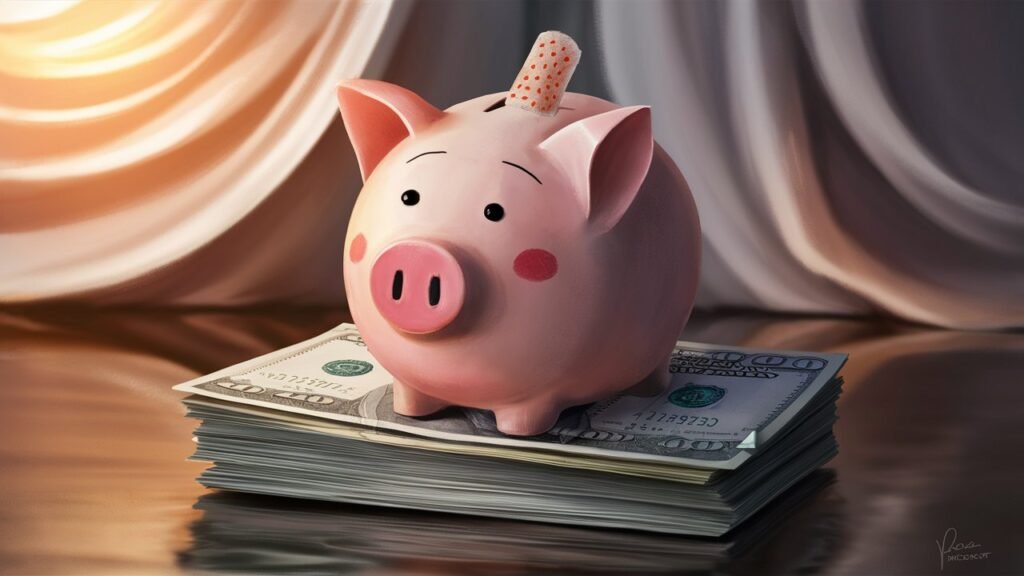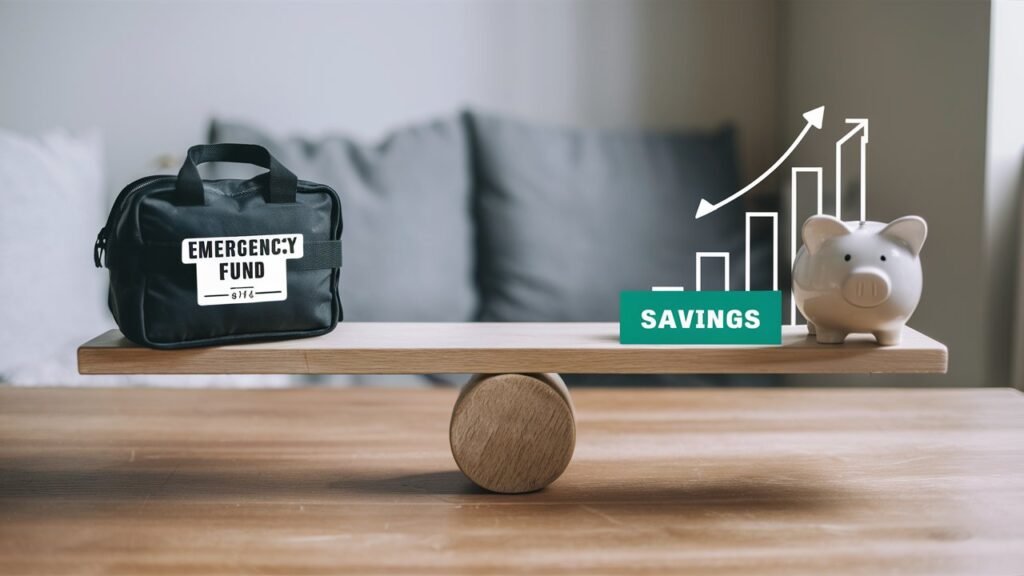Introduction
How Much Should You Save? Building the Perfect Balance Between Emergency Fund and Savings is the backbone of financial security, finding the perfect unassailable space to maintain one and contribute to long or short-term savings can be rather difficult. Before we start talking about the strategies, the roles these two play in contributing to one’s financial wellness should be appreciated.
An emergency fund is money saved for emergencies and unexpected expenses. So you can think of it as a safety net financial safety net that will help you during medical emergencies car repairs or layoff from work. Savings, on the other hand, are money set aside for planned goals like buying a house, starting one s business, or retirement. In a nutshell, both are vital, yet each serves a different function.
Balancing these two is very vital for stability in finances. Lack of emergency funds can lead to accumulated debt for even minor unexpected expenses or severe strain on finances. On the contrary, constant emergency work without savings may leave one unfit for a future opportunity or long-term end goal. For instance, you might sort a spur-of-the-moment car repair bill but would be left destitute in a matter of moments if you ever needed to go on a vacation or are ever tempted to build a nest egg for retirement.
This article will show you how you can chart out your own customized savings strategy based on your unique financial situation. By looking at your income, expenses, and goals, you will know what amount you can divide between your emergency fund and long-term savings. The end goal? A really solid financial platform of immediate security and long-term wealth.

Understanding Emergency Funds
An emergency fund is a financial safety net put in place to guard against unexpected costs, such as medical expenses, vehicle repairs, or loss of income due to unemployment. Compared with normal savings-where funds are kept to be accessed in the course of a plan to help improve one’s lot-emergency funds are distinguished by their literal liquid character, accessibility, and perhaps, more importantly, by the fact that any such funds can provide for emergencies, as opposed to safety nets during a drop from planned participation into tied cash flows.
What Is An Emergency Fund?
An emergency fund is funds set aside for emergencies. This money is separate from regular savings even though it can still be easily accessed. This fund should remain untouched for any planned expenses.
How Much Should the Emergency Fund Contain?
The typical recommendation calls for three to six months’ worth of basic living expenses. How much varies depending on such factors as job security, family size, health concerns, or personal risk tolerance. Someone who earns an inconsistent income may need a larger emergency fund than single individuals with steady jobs.
Where To Keep Your Emergency Fund
Your options for storage include a high-yield savings account, a money market account, or a cash reserve. These investments are liquid and have little risk, so your funds will be available in your time of need. While returns on your accounts are quite low, liquidity and low risk are of much more importance than the return when considering which account is best for your savings.
Building and maintaining an emergency fund is one of the most important steps toward financial stability and peace of mind. Start small but stay consistent. It is important to periodically review your fund for adequacy as your circumstances change.

Understanding savings: The basics
What Do You Mean By Savings?
Savings are a proportion of income that goes towards achieving specific financial goals. These can be short-term goals, such as vacations or weddings, or long-term ones, such as the purchase of a house or saving for retirement. Savings differ from emergency funds in that they are explicitly meant for future goals rather than for unforeseen expenses, and as a result, they are somewhat less accessible.
Types of Savings
1. Short-term savings:
Focused on getting immediate things, be they fund vacationing, covering wedding costs, or down payment on a car.
2. Long-term savings:
Aimed at future stability, this includes retirement accounts or investments.
How Much Should You Save for Future Goals?
• Prioritize Goals: Segment your goals between high-priority ones-e.g., retirement-and low-priority ones-e.g., vacation.
• Set Targets: Set specific amounts for the individual goals and make sure that the savings plan corresponds closely with your income and time frame.

How to Balance Emergency Funds and Savings.
You should strike a balance between emergency funds and savings to effectively manage your finances. You need both types of accounts, and here’s how to maintain that balance.
Two Good Reasons to Save for Both Emergencies and Your Future
Emergency funds and savings are meant for entirely different purposes. Emergency funds work as a backup against unforeseen expenses-a medical emergency or a car repair, or something like a job loss-a can-help-you-with-your-unexpected-life-expenses fund. Savings accounts are mainly for planned money investments, such as trips, buying a house, or funding an education. Mixing the two will either render you unprepared to face crises or make you delay your long-term plans. Relying on one way or the other leaves you vulnerable, either to inability to meet emergencies or to failure to make your dreams come true.
How to Prioritize Between Emergency Funds and Savings
Start off with an emergency fund that can cover vital expenses for 3-6 months. Once you have that in place, you can now focus on savings goals such as traveling, retirement, or buying a new car. Clear progression will ensure both your immediate and your future finances are secure.
On Factors to Be Considered for a Balance
The way to go to cover both your emergency fund and savings will be dictated by your income, expenses, and financial goals. Check your lifestyle, career changes, and the changing needs of your family regularly, and adapt your contributions accordingly. Flexibility and planning give real opportunity for one to attain financial resilience and growth in the long term.
Balancing emergency funds and savings enables you to weather the storms of life while, at the same time, making significant strides toward your goal.
Strategies for Achieving a Good Balance
Obtaining that financial balance necessitates good planning and consistent work. Here are five practical approaches that will help you in achieving the financial balance:
1. Create a Budget
Create a budget to outline your income, your expenses, and the funds available for savings. Budgeting apps and spreadsheets will help you keep track of your spending and highlight areas where you can make changes.
2. Create A Realistic Savings Target
Your savings targets should be in sync with your lifestyle and income. Use SMART (Specific, Measurable, Achievable, Relevant, Time-bound) goals and you will know just how to go about it and achieve it.
3. Make Savings Automatic
Set up an automatic transfer from your checking account to either your savings or emergency fund accounts. This way, the money goes away automatically-whenever it enters the checking account. This will ensure that savings are being made on a regular basis with no chances of shying away from the target.
4. Follow the 50/30/20 Rule
Allocating your income: 50% must go to needs, 30% for wants, and 20% will be for savings and debt repayment. You can always adjust it accordingly depending on your financial priorities short and long term as well as your income and expenditure.
5. Review and Revise
Your plans should reflect the changes in your life. Review your budget and savings goal periodically and make the necessary adjustments with a change in income, expenditures, or priorities. Periodic adjustments will help you stay on course.
Tapping into these approaches puts you one step closer to maintaining a balance between your financial needs, wants, and future goals.

Tips on How to Save Efficiently
1. Cut Down on Unneeded Expenses
Take a serious look at your spending habits and determine what you can forgo to save more money. Cancel any underused subscriptions, cut back on date nights, and limit impulse buys. Your emergency fund or savings account won’t mind these little compliments as you keep adding to your growing financial cushion.
2. Make More Money
You may choose to increase your income through side jobs, freelance work, or you could even negotiate for a raise at your current job. Once you get extra cash, use it in building the savings or emergency funds which will make your financial growth happen rapidly.
3. Put Windfalls to Good Use
Avoid spending the entire amount when you receive a tax refund, a bonus, or an unexpected financial windfall. Instead of indulging in a shopping spree, allocate a portion of the money to your emergency fund and a portion of it to your savings as creating a good financial base requires these two things in a symbiotic relationship with one another and their own equilibrium.
These cool yet efficient methods can maximize your savings and allow you to secure matters in the financial domain.

Conclusion
Balancing emergency funds and savings is a very important safety settlement in terms of getting oneself financially secure. While emergency funds operate as a cushion in contingencies, savings can help fulfill any long-standing goals. Though the ideal balance lies in individual circumstances like income, expenses, or financial goals, it will be wise to start small and stay with it, tours in any direction to check out devotion toward a certain action plan, aligning the course of it bringing considerations towards the evolving needs. These are the steps that will give you the much-needed solid foundation and mold you for the unforeseeable and future challenges.
If you are quite serious about making this balancing act with emergency funds and savings, start by saving a part of your pay monthly. Consistency is crucial. And your future self will appreciate your adulting!
FAQs
1. Why is it important to balance emergency funds and savings?
Balancing emergency funds and savings ensures financial security. Emergency funds provide immediate financial relief in case of unexpected events, while savings help you reach long-term financial goals. A balance between both helps you manage short-term needs and plan for the future.
2. How do I know the perfect balance between emergency funds and savings?
The ideal balance depends on your personal financial situation, such as income, expenses, and goals. There is no one-size-fits-all solution. It’s essential to assess your needs and adjust your strategy as circumstances change.
3. How can I start building my emergency fund and savings?
Start small by setting aside a small portion of your income each month. For your emergency fund, aim for 3 to 6 months of living expenses. For savings, prioritize your financial goals, such as retirement or buying a home. Consistency is key.
4. How often should I revisit my financial plan?
It’s important to revisit your financial plan at least annually or whenever there are significant changes in your life, such as a job change, a new expense, or a change in financial goals. Regular check-ins ensure you stay on track.
5. What should I prioritize: emergency funds or savings?
It depends on your financial situation. If you don’t have an emergency fund, prioritize building one first. Once you have a sufficient emergency fund (3-6 months of expenses), then focus more on savings for your goals.

